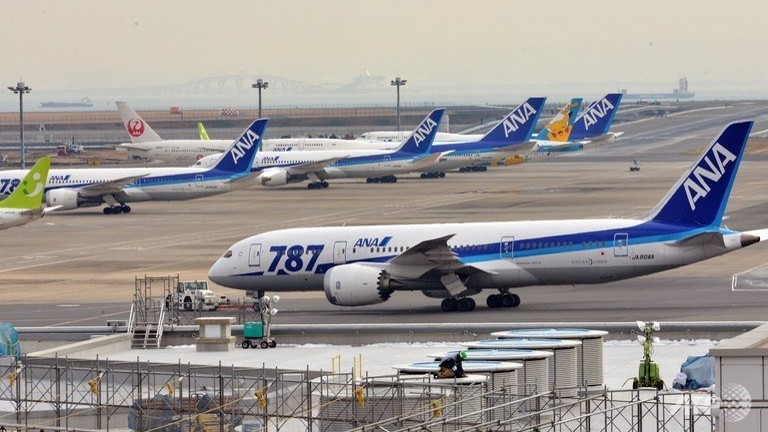FAA says 787 can fly after battery systems modified

This file picture taken on January 16, 2013 shows a Boeing 787 dreamliner towed
by a tractor at Tokyo's Haneda airport. (AFP/Yoshikazu Tsuno)
WASHINGTON: The US Federal Aviation Administration (FAA) on Thursday issued formal approval of Boeing's 787 battery fix that will clear the way for the troubled aircraft to fly again after a three-month grounding.
The move was quickly followed by regulators in Japan who said they would also allow the resumption of flights by the grounded aircraft following the FAA order, which they said would come into effect Friday.
Japan Airlines (JAL) and domestic rival All Nippon Airways (ANA) account for half the Dreamliners in service, and have said it could take several months to complete the battery fix at centre of the crisis and get the planes in the air.
The FAA and other regulators grounded the 50-strong worldwide Dreamliner fleet in mid-January after two failures of the innovative lithium-ion batteries on the jetliner.
The FAA's new airworthiness directive (AD) for the next-generation plane requires the installation of modified battery packs and their respective chargers, as well as battery enclosures and ducts.
"Once the aircraft are in compliance with the AD, they can return to service," an FAA spokesman said in an email.
The directive caps a difficult three months for Boeing and its 787 customers, which have had to cancel thousands of flights and rearrange schedules after the grounding.
The FAA action technically affects just the six 787s of United Airlines, the sole US airline owning the aircraft.
"But we expect foreign civil aviation authorities will order the same action," the FAA spokesman said.
Shortly after, an official at Japan's transport ministry said: "As the FAA is to approve the resumption as of Friday morning US time, we will take the same step."
ANA declined to comment on the development, while JAL could not be immediately reached.
Other airlines flying the Dreamliner include Ethiopian Airlines and Polish carrier LOT.
In the FAA's directive, the air-safety regulator said the battery modifications would minimise the safety risk posed by the overheated batteries in the January incidents.
Investigators are still unable to pinpoint the cause of the battery failures, the FAA noted.
The National Transportation Safety Board, which is probing the January 7 battery fire aboard a Japan Airlines 787 parked at a Boston airport, has not yet determined the cause, it said.
The same was true for the Japan Transport Safety Board, which is investigating the battery failure on an ANA plane that forced an emergency landing in Japan, the agency said.
The FAA said it was issuing the directive without waiting for public comment, citing the grounding's cost to operators of the 787.
"While necessary in the short term to address the unsafe condition, this (grounding) caused a significant economic burden on domestic and international operators of Boeing Model 787-8 airplanes," it said.
"The purpose of this AD is to allow the aircraft to return to service as soon as possible by mandating a modification that will address the unsafe condition."
The FAA estimated the cost of the required modifications on the six US-registered airplanes at US$2.8 million.
United Airlines, reporting first-quarter earnings Thursday, said it took an US$11 million charge related to the 787 grounding.
United chief executive Jeff Smisek said that domestic 787 flights would resume in May and the airline's first international 787 service -- a new nonstop link between Denver and Tokyo -- would begin on June 10.
"The grounding of the 787s had an impact on our bottom line and we are eager to get this remarkable aircraft back up and flying," he said.
Shares in parent United Continental Holdings tumbled 2.0 per cent and Boeing shares were up 1.3 per cent in late-afternoon trade in New York.
On Wednesday, Boeing, reporting a 20 per cent year-on-year jump in first-quarter profit, said the problems had only a "minor" financial impact.
The aerospace giant said it had begun battery modifications on 10 aircraft owned by airlines and nine planes being readied for delivery, and the installations were expected to be completed by mid-May.
Boeing confirmed its target of delivering more than 60 787s during 2013.
What the stars mean:
★ Poor ★ ★ Promising ★★★ Good ★★★★ Very good ★★★★★ Exceptional
Latest News
More News
- First members of Danang International Finance Centre revealed (December 22, 2025 | 17:39)
- Human-centred governance seen as key to AI development (December 19, 2025 | 18:19)
- Top 10 notable events of Vietnam’s industry and trade sector in 2025 (December 19, 2025 | 14:00)
- Tungsten surges to 12-year high as world enters a new 'black gold' race (December 18, 2025 | 17:27)
- Vietnam’s coffee exports set new record despite price pressures (December 18, 2025 | 17:13)
- Garment and textile sector seeks new growth after volatile year (December 18, 2025 | 17:01)
- VinSpeed and Siemens strengthen cooperation for high-speed rail development (December 18, 2025 | 16:53)
- High-tech adoption for TH true MILK (December 18, 2025 | 13:39)
- Takeda supports health resilience amid climate change challenges (December 18, 2025 | 12:39)
- Mondelez Kinh Do - a chapter of purpose-led leadership in Vietnam (December 18, 2025 | 09:44)


















 Mobile Version
Mobile Version